Is it possible to get a cat used to a dog? Or are all efforts in this regard doomed to fail? Is it a pipe dream to think that cats and dogs can live together happily in the same home? Or is that also some kind of utopian delusion? Are cats and dogs natural enemies? Well, not necessarily. It depends on a number of different factors. Sometimes it’s absolutely possible to socialise cats and dogs. They might even make a real dream team and end up being best friends for life! However, in order to familiarise a cat with a dog, you’re going to need a lot of skill and sensitivity.
Are dogs and cats rivals?

There’s a stereotype about cats and dogs being rivals, but this doesn’t always have to be the case. A lot depends on the individual personalities of the animals and their prior socialisation. Some cats and dogs will hit it off right away and maybe even form deep friendships, while others won’t get along at all. Before you start the process of familiarising one animal with another, it’s important to observe their behaviour carefully and always take their needs and individual characters into account. Even when you’re socialising two cats or two dogs, everything depends on achieving the right chemistry!
Can dogs and cats be accustomed to each other?
It is possible to get dogs and cats used to each other. However, a gentle introductory phase and subsequent training are necessary to avoid tension and build a positive relationship between them. It requires patience, time, and keen observation to ensure that both the cat and the dog feel safe and comfortable. If you make sure they have enough space and retreat options, they can gradually get closer and live together harmoniously.
RECOMMENDATION:
Dog-friendly cat breeds: When cats and dogs get along well, it’s usually because they’ve been successfully socialised to enjoy each other’s company. That being said, there are some cat breeds with particular characteristics that make it easier for them to get along with dogs:

Animals obtained from foreign animal-welfare organisations are usually already used to other species due to the fact that they’re often kept together. This makes it doubly worthwhile 💕 to give such animals a new home!
How long does it take to socialise a cat and a dog?
The time it takes for cats and dogs to develop mutual respect and willingly share a home with one another will vary depending on their personality and prior history. Sometimes they’ll only need a few weeks to become familiar with one another, but it can also take several months. Whatever you do, don’t rush anything! It’s important to take things slowly and carefully. You should always make sure the cat and the dog don’t ever feel overwhelmed by the situation. When it comes to socialising your cat with another animal, time is a crucial factor.
What problems can occur when attempting to familiarise a cat with a dog?
A number of problems can occur when familiarising a cat with a dog. Why? Because cats and dogs differ from one another in many ways! For example, cats are independent types, whereas dogs are fixated on their human owners. Cats and dogs also behave differently in everyday life: for example, while dogs will look to their human owners in the event of danger, cats prefer to flee and retreat to a safe place. In addition to these differences, cats and dogs are also likely to experience communication problems, often because they misinterpret the other species’ body language. If a cat has never had contact with a dog before (and vice versa), problems can certainly arise when they encounter each other for the first time:
- 1. Atypical behaviour: When you introduce a cat or a dog to a new animal, they’ll sometimes react by exhibiting unusual and atypical behaviour. They might suddenly become insecure, anxious and want to dominate the other animal.
- 2. Stress reactions: Some animals will react to a new flatmate with joy and excitement, while others will become frazzled and stressed out. Introducing cats and dogs to one another can trigger stress reactions in both species and even lead to health problems.
- 3. Territorial behaviour: Imagine being the sole boss of your territory one moment, only to be told in the next that you have to share everything with a complete stranger. If you confront a cat or a dog with this kind of situation, they might try to assert themselves and defend their territory. This, in turn, will make conflicts and arguments inevitable.
- 4. Aggressive behaviour: When animals feel threatened by a perceived intruder in their private territory, they might display aggressive behaviour in an attempt to intimidate the unwelcome guest and show them who’s boss. For animals who find themselves in this situation, attack is the best defence!
- 5. Hunting instinct: Your dog might no longer understand the world: “That’s a cat. Why am I not allowed to chase a cat?” Every dog breed will want to live out its own specific hunting instinct; this impulse to hunt is something modern dogs inherited from their distant ancestors, the wolves.
Love, peace and harmony? When a cat and a dog have been successfully socialised, does it mean their carefree coexistence is guaranteed forever? At this point, the animals will have likely learned to accept and respect each other, usually because they’ve become familiar with the other’s idiosyncrasies. For example: “When I see the cat wagging its tail”, says the dog, “it means I’d better watch out”. But there still might be the occasional squabble between man’s best friend and the house cat. They might clash with one another, and sometimes they’ll share whatever they’re fighting over. It’s usually something both of them want, such as delicious food.
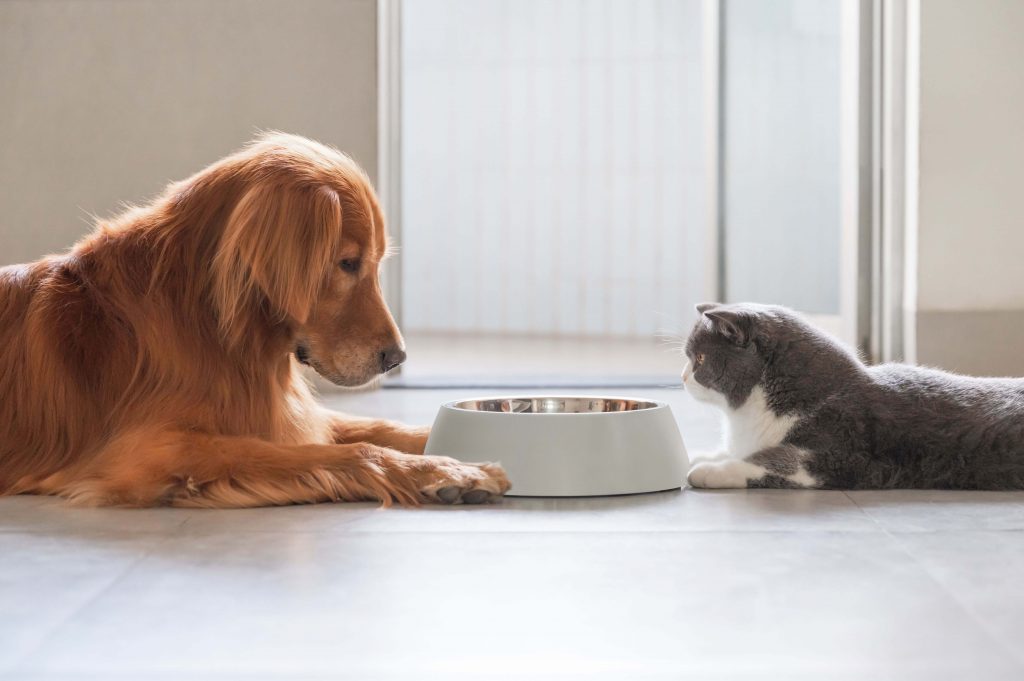
PLEASE NOTE:
Animals can get jealous 💔. Make sure neither 🐶 ♥️ 🐱 gets a raw deal!
What conditions need to be in place for cats and dogs to be able to live together in harmony?
The first thing on your to-do list should be to create the conditions necessary for your cat and dog to be able to live together peacefully. What are the things cats and dogs need to feel at home at your place? When it comes to equipment, cats and dogs aren’t as different as you might expect. In fact, when it comes to what they need at home they’re actually quite similar. Cats need a few items and pieces of furniture that dogs can do without – for example, scratching posts and litter trays. But apart from that, the only major differences they have can be found in their social behaviour. You should always take these behavioural factors into account if you want your cat and dog to live together in harmony:
- Provide spaces they can retreat to: Both cats and dogs should be able to withdraw from interacting with one another, plus each of them should have their own resting areas.
- Ensure safety: Make sure both your cat and your dog are protected from aggressive behaviour and won’t suffer any serious injuries.
- Keep an eye on both: Trust is good, but control is better! Especially in the first few weeks, you shouldn’t leave your cat and dog alone. In other words, in the beginning, don’t let them figure things out by themselves.
- Keep an eye on both: Trust is good, but control is better! Especially in the first few weeks, you shouldn’t leave your cat and dog alone. In other words, in the beginning, don’t let them figure things out by themselves.
- Check-ups at the vet: Both animals need a check-up once a year. Are your cat and your dog in good health? Are they both protected against common diseases found in their respective species?
Getting dogs used to cats – Here’s the best way to do it
If you want to get a dog used to a cat, you should plan the familiarisation process carefully in advance and then proceed step by step:

- Step 1: Spatial separation
Create separate areas for your dog and cat so that they don’t meet each other directly right away. Make sure both animals have enough space and plenty of opportunities to retreat.
- Step 2: Scent invasion
Dogs and cats have a keen sense of smell. In order to familiarise them with each other’s scent, simply swap their toys and blankets.
- Step 3: Practice being together
When you do activities together, chances are you’ll grow closer together. Build trust and encourage cooperation between your cat and your dog by training them to hang out and do stuff with one another.
Here’s what a training session might look like: A short visit from the dog to the cat’s room, initially with the dog on a lead so that he or she can’t chase the cat. In this scenario, the cat gets to stay wherever it wants in the room. Reinforce the experience positively: Say the name of the cat and dog out loud, praise them and give them both a reward. Let the animals set the pace of familiarisation, and give them all the time they need. If all goes well, you can extend the length of time they spend together the next time.
TIP:
Pay attention to their body language: while you’re training your cat and dog to spend time together, try to read their body language for any signs of stress and discomfort and, if necessary, stop the session immediately!
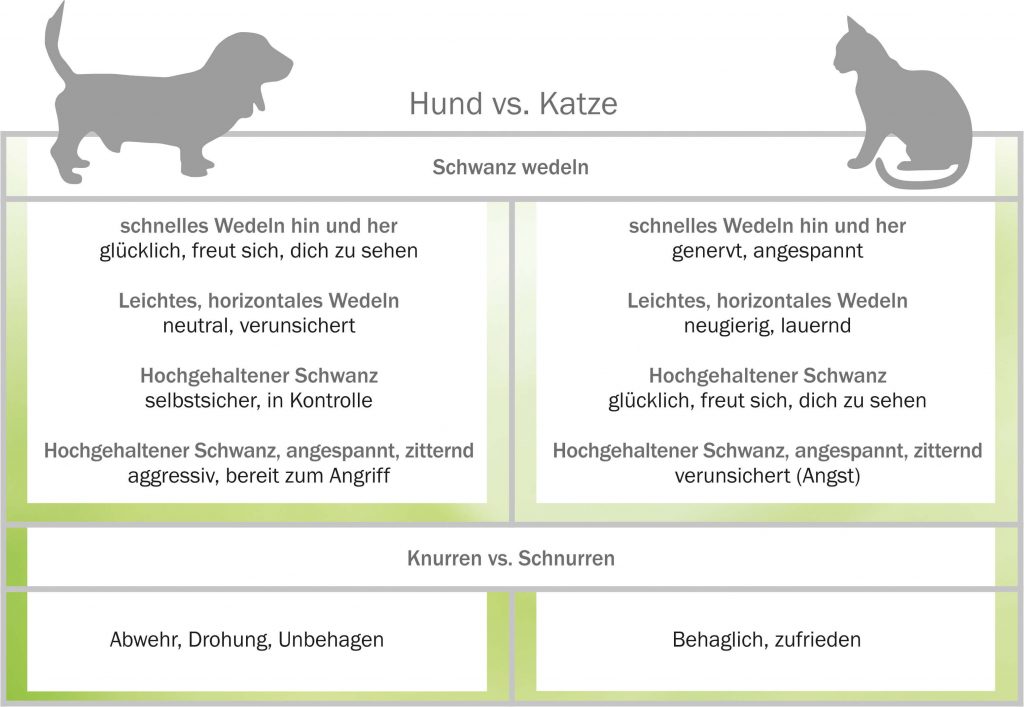
Getting your cat and dog used to each other – Key things to should look out for
What should you look out for when you’re trying to get your cat and dog used to each other? There are a few key things you should bear in mind when familiarising pets with one another, especially if you don’t want their first meeting to turn into a fiasco. Remember that cats and dogs have individual personalities; each one of them is unique and has its very own character. It’s best to get to know the candidate beforehand to gain an impression of their character: What kind of personality do you have in front of you? Does their mentality match the mindset of the other animal?
PLEASE NOTE:
Some animals are solitary creatures with no desire to have any other animals around them; for these characters, it won’t matter whether the other animal is a member of their own species or another! If you have an animal with this kind of attitude at home, save yourself – and them – the stress of trying to make them bond with another creature.
How to prepare for the first encounter
To prepare for the first encounter between a cat and a dog, you should take the following steps: first of all, before the animals meet, give the new flatmate time to get used to its new surroundings. The best place for this is in a separate area, a room reserved just for them. No matter whether it’s a cat or a dog, their things should be in this room: food bowls, baskets, cosy blankets, toys, etc. If the new animal is a cat, their litter tray should also be in the room, of course. You should then choose a neutral living area as the meeting place for the first encounter. Both animals can visit this neutral space beforehand, but make sure they don’t leave any scent marks there.
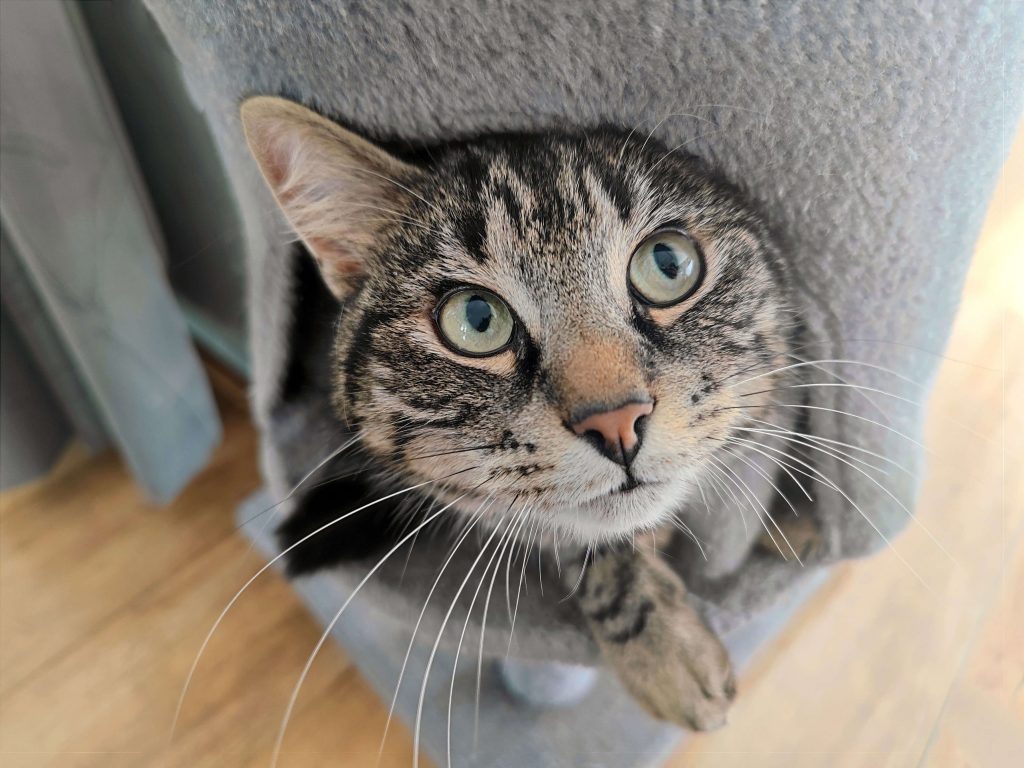
How to proceed during the first encounter
When your dog and cat meet for the first time, it’s important to proceed with the utmost caution and sensitivity. Here are a few things you should bear in mind:
- Neutrality: Carry out the first meeting in a relatively neutral space in your home – it should be an area that neither the cat nor the dog considers to be its own territory.
- Safety: Keep the dog on a leash. This will prevent it from chasing the cat but also from getting injured if the cat reacts aggressively or fearfully.
- Opportunities for retreat: Make sure the cat has a space it can retreat to if it feels uncomfortable: for example, a raised area or a cat flap.
- Body language: Pay attention to the body language of both animals. What is the body language of the cat saying? What is the dog’s behaviour telling you? Are they curious and calm or are they showing signs of tension and fear?
- Short encounters: Keep the animals’ first meeting as short and positive as possible. If it goes well, you can gradually increase the duration of the encounters.
- Patience: Don’t expect too much at the beginning! Be patient and don’t force the dog or the cat to interact if they’re not yet ready.
Immediately before the first meeting
Immediately before the cat and the dog meet for the first time, you should make sure the meeting area is clean and safe: remove anything that could be a distraction, such as food or toys. Make sure the dog and the cat have had a good meal before the meeting. Also make sure they’re not excited for some other reason. In other words, they should both be as relaxed as possible. Avoid loud noises and hectic activities immediately prior to the meeting.
How you should behave during the first encounter
During the first encounter of the cat and the dog, you should make sure you’re very calm yet attentive. Remain as relaxed as possible, because your chill approach will have a positive effect on the animals. Let the animals set their own boundaries. You should only intervene when you notice signs of stress or aggression. If the situation escalates, you should separate the two and try again some other time.
How to keep your cat and your dog together for life
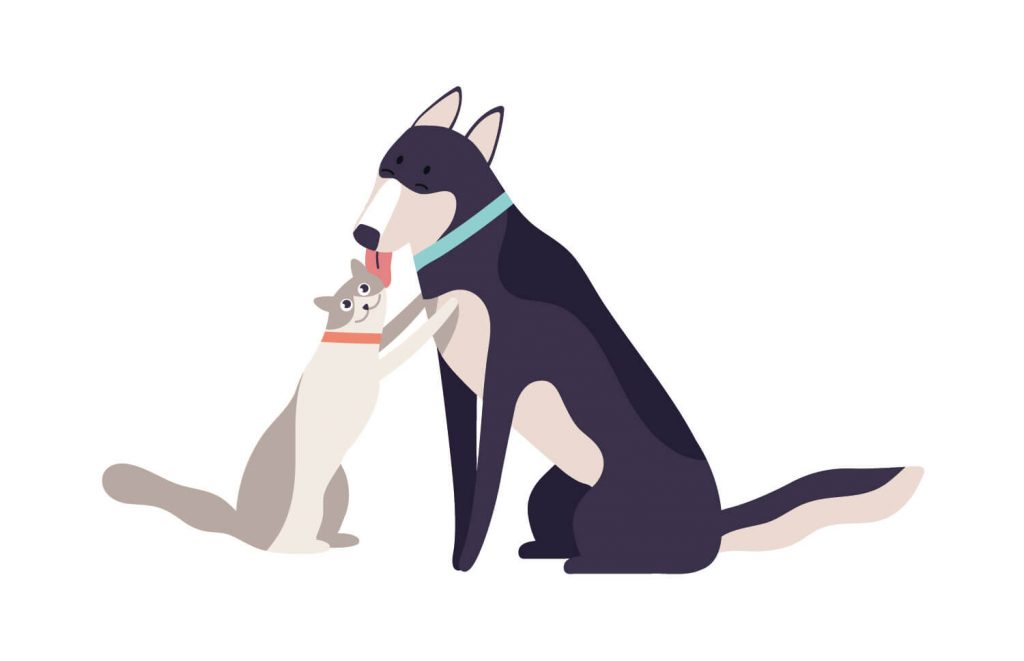
It’s absolutely possible to keep a cat and dog together for life, but only if you make sure the animals have a harmonious relationship. This includes recognising their individual needs and always taking them into account. A dog has a different set of daily requirements than a cat: for example, dogs will need to eat and be taken on walks three times a day, at which point they should also have the opportunity to romp around and play. At night, however, dogs need to sleep. Cats, on the other hand, have a completely different biorhythm: they’ve been known to sleep for up to sixteen hours during the day, so they won’t want to be disturbed. If you have an outdoor cat, it will want to go on the prowl, but only when it starts to get dark outside, because that’s when its prey is out and about…
ERGO: Live and let live! If you allow your cat and your dog to engage in a lifestyle that fits their specific needs, then it’s possible they won’t just get along – they might even enjoy a lifetime of wonderful moments together!
Stay patient and don’t give up
Patience is key when it comes to building trust and strengthening the bond between cats and dogs. Still, it can take some time for these two to get used to each other. It’s important that you don’t give up straight away; continue to be patient, even ifyou experience some setbacks. Remember that animals also have a deep emotional world; they have thoughts and feelings just like the rest of us! Otherwise they wouldn’t have all those dreams we see them having. And remember: once the spark between them has been ignited, they’ll be faithful forever!
Separate rooms as spaces for a safe retreat
Separate rooms that function as spaces for a safe retreat are helpful for giving cats and dogs their own protected areas. These are valuable niches! If things get too wild or unpredictable for one of them, these spaces allow them to retreat and calm down. For the dog, this might be a basket in a quieter room. Here, you should make sure your dog always has fresh drinking water, a few toys and a place to lie down and rest. For the cat, this might be a cosy raised area on a shelf or high up on a scratching post. From an elevated vantage point, your cat will be able to keep a relaxed eye on its surroundings and take a good nap.
At what point can I leave my dog and cat at home alone?
The point at which you can leave your dog and your cat at home alone depends on various factors. How have they behaved so far when they’ve spent time together? Do they generally have a problem with being alone – that is, even without the other one being there – or are they used to being without you for longer periods of time? Cats generally cope better with being alone than dogs. But there’s no universal rule. Try a dress rehearsal: leave the two of them home alone for a short time and observe their behaviour, say, with a hidden camera. If they show any signs of fear or stress, go back to having them practice being together.
What should I do if the socialisation process doesn’t work?
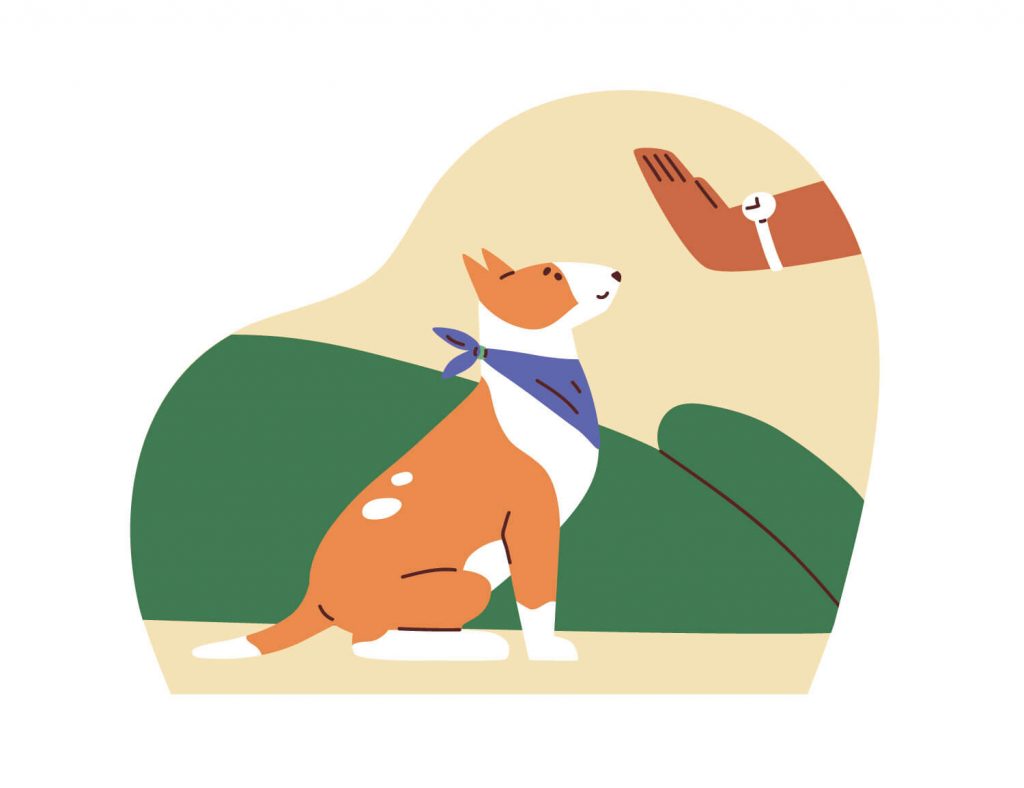
If the socialisation process doesn’t work as you’d hoped, try some other approaches:
1. Remain calm: Stay calm and composed, even if you haven’t been able to familiarise your cat and dog as quickly as you hoped. Please don’t put any additional pressure on them; that will only stress them out.
2. Separation: Try separating the two temporarily by putting them in different rooms. Give them the opportunity to calm down and release any tension they might be feeling.
3. “Bach flowers” + pheromones: One way to make the socialisation process easier is by using herbal essences. Find out which substances are most suitable in your case.
4. Get professional help: If you think you could use some professional help with the cat-and-dog socialisation process, reach out to an animal trainer or behavioural specialist who can give you the support you need.
ATTENTION:
Please avoid displaying any kind of aggressive behaviour when trying to socialise cats and dogs! You cannot force them to get along! If you want a cat and a dog to form a lifelong bond, you’re going to need a lot of patience, a deep sense of their individual needs and probably a bit of luck. Remember: sometimes it works, sometimes it doesn’t. If you find yourself becoming aggressive, stop immediately before it becomes too stressful for everyone involved.
What’s the best time to get your cat and dog used to each other?
The best time to familiarise a cat and a dog is when both animals are still young and able to easily adapt to new situations. When they’re still puppies and kittens, it’s likely they haven’t had any bad experiences with humans or with their fellow four-legged friends. They’re usually still curious and open to trying anything. At this point in their lives, it’ll be much easier to get them interested in something new. They’ll even be more daring and brave than adults of the same species. Again, it’ll be easier to playfully introduce them to strange and unknown things, plus they’ll learn faster than the “oldtimers”.
What’s the best time to familiarise a cat and a puppy?

The best time to familiarise a cat and a puppy is during the habituation phase, which extends through to the puppy’s 16th week.This is the time when the young pup is getting used to its new environment and learning to categorise what’s safe and what should be avoided. In this phase, a puppy should get to know everything that’s going to be surrounding him or her in the future. It’s not particularly difficult to get a puppy interested in new things at this point in their lives. Just like human children, puppies are incredibly curious! They’re going to want to explore everything, including that furry feline friend on the scratching post. Still, make sure to introduce the puppy to your cat slowly, calmly and step by step.
What’s the best time to familiarise a dog and a kitten?
You shouldn’t try to familiarise a dog and a kitten before the kitten is 4 months old. It’s totally understandable that you can’t wait to finally bring your cute little fluff ball home to meet your pooch! But remember, it’s better not to separate the kitten from its family too soon. Make sure to leave the kitten in the care of its mum and siblings for as long as possible; in this case, the longer the better! Kittens need to spend their first months becoming physically fit and mentally balanced, so it’s best not to plan the big move into a new home with a dog until they’re 12 weeks old.
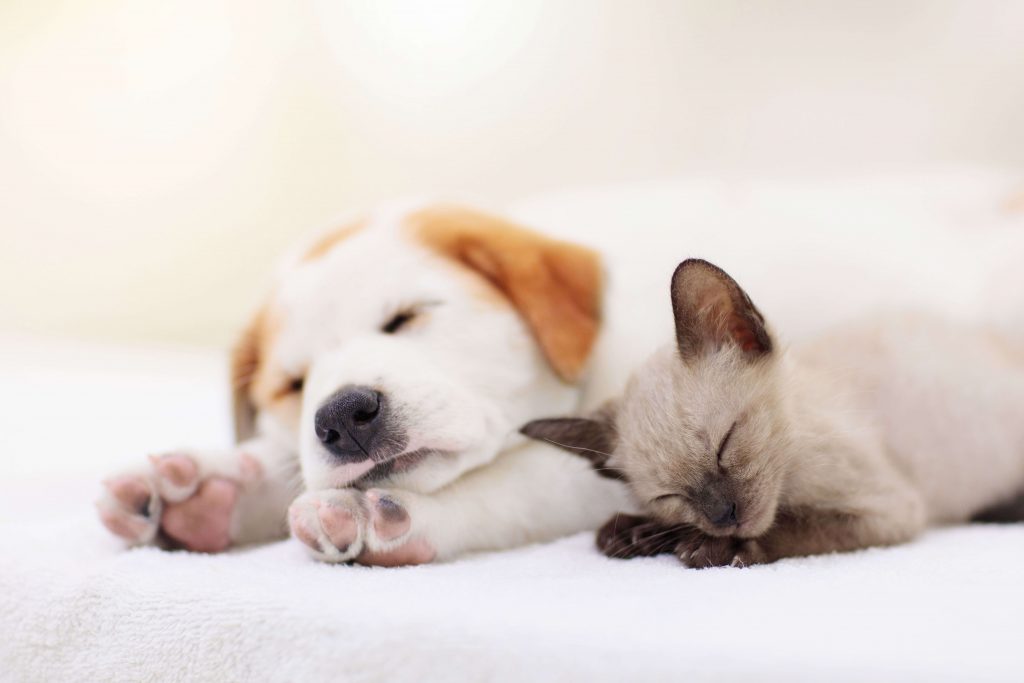
TIP:
Give your kitten time to settle in and adapt to life with human beings. And don’t forget to make sure you get everything ready for your furry little tiger: safe spaces they can retreat to, separate feeding spots for your cat and dog, and two litter trays that are absolutely off-limits to the dog! Why? Because some dogs like to eat cat faeces …
Frequently asked questions – Getting your cat used to a dog
The best time to familiarise cats and dogs is when they’re still young and therefore easily able to adapt to a new situation. When they’re kittens and puppies, they learn new things very quickly, which means it’s the ideal time to get them used to each other.
The best time to bring a cat and a dog together is during the habituation phase. In this phase, a young dog will be curious, open-minded and want to try out everything. Your dog will learn very quickly at this point, and this will make it easy to gradually introduce him or her to a new cat.
You shouldn’t bring a dog and kitten together until the kitten is at least 4 months old. Before you introduce them to one another, prepare everything for the new arrival: this includes a room for the cat only, a number of raised spaces where the cat can retreat to, separate feeding stations and the cat’s own litter trays.
The time it takes for a dog and a cat to respect each other and live together side-by-side will vary depending on their personalities and prior experiences. Sometimes the familiarisation phase only takes a few weeks, sometimes several months.
Yes, it’s possible to get cats and dogs used to each other. However, in order to be successful, it’s essential to have a very gentle initial introduction phase and some follow-up training after that. It takes a lot of patience, a lot of time and excellent observational skills to ensure that a cat and a dog eventually feel comfortable with each other.
The first thing you should do is separate the cat and the dog and put them in different rooms. Give them the opportunity to calm down. Consider asking a professional for assistance; an animal trainer and/or a behavioural specialist can help with the socialisation process.
